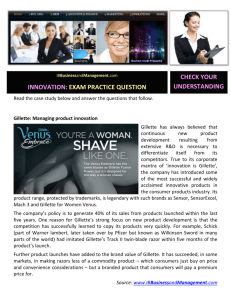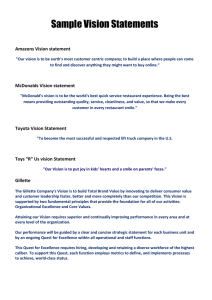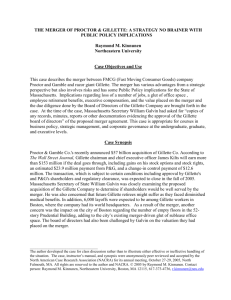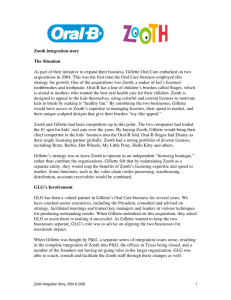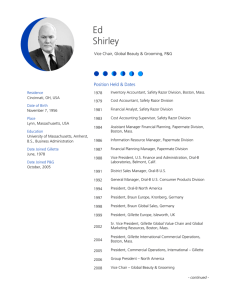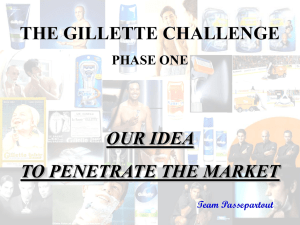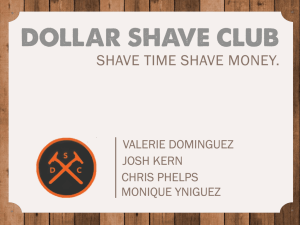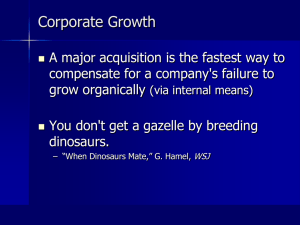Multi Brand King
advertisement
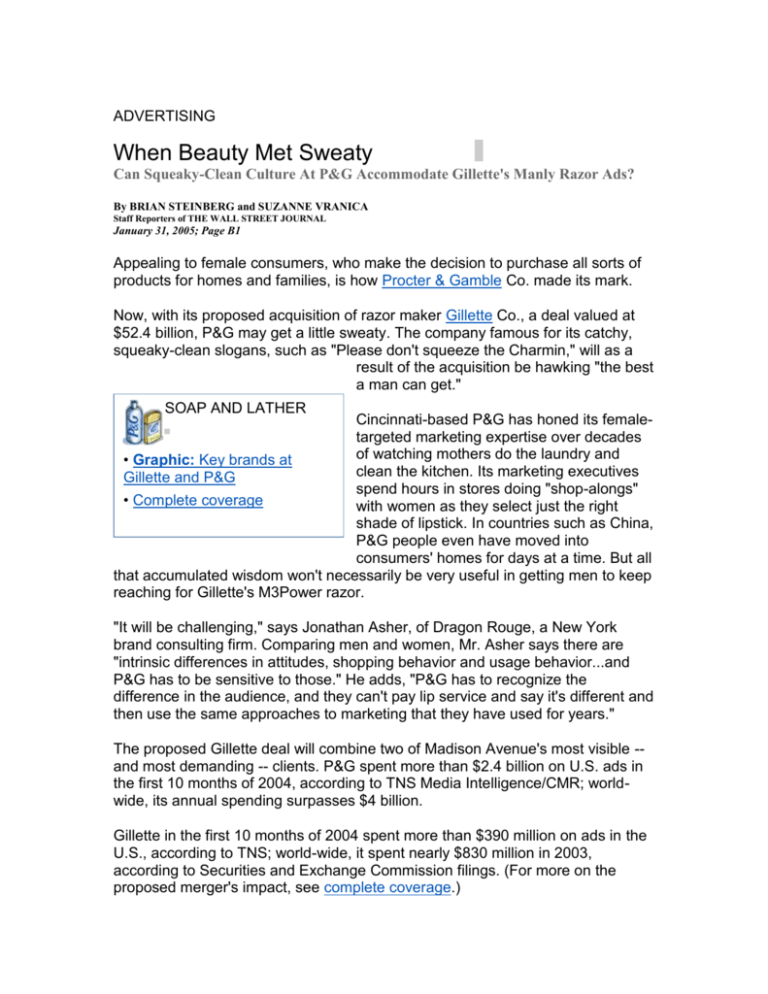
ADVERTISING When Beauty Met Sweaty Can Squeaky-Clean Culture At P&G Accommodate Gillette's Manly Razor Ads? By BRIAN STEINBERG and SUZANNE VRANICA Staff Reporters of THE WALL STREET JOURNAL January 31, 2005; Page B1 Appealing to female consumers, who make the decision to purchase all sorts of products for homes and families, is how Procter & Gamble Co. made its mark. Now, with its proposed acquisition of razor maker Gillette Co., a deal valued at $52.4 billion, P&G may get a little sweaty. The company famous for its catchy, squeaky-clean slogans, such as "Please don't squeeze the Charmin," will as a result of the acquisition be hawking "the best a man can get." SOAP AND LATHER Cincinnati-based P&G has honed its femaletargeted marketing expertise over decades of watching mothers do the laundry and • Graphic: Key brands at clean the kitchen. Its marketing executives Gillette and P&G spend hours in stores doing "shop-alongs" • Complete coverage with women as they select just the right shade of lipstick. In countries such as China, P&G people even have moved into consumers' homes for days at a time. But all that accumulated wisdom won't necessarily be very useful in getting men to keep reaching for Gillette's M3Power razor. "It will be challenging," says Jonathan Asher, of Dragon Rouge, a New York brand consulting firm. Comparing men and women, Mr. Asher says there are "intrinsic differences in attitudes, shopping behavior and usage behavior...and P&G has to be sensitive to those." He adds, "P&G has to recognize the difference in the audience, and they can't pay lip service and say it's different and then use the same approaches to marketing that they have used for years." The proposed Gillette deal will combine two of Madison Avenue's most visible -and most demanding -- clients. P&G spent more than $2.4 billion on U.S. ads in the first 10 months of 2004, according to TNS Media Intelligence/CMR; worldwide, its annual spending surpasses $4 billion. Gillette in the first 10 months of 2004 spent more than $390 million on ads in the U.S., according to TNS; world-wide, it spent nearly $830 million in 2003, according to Securities and Exchange Commission filings. (For more on the proposed merger's impact, see complete coverage.) One trend working in P&G's favor: Men increasingly are interested in personal hygiene and grooming, buoying sales of personal-care products. World-wide sales of shower gels, for example, rose 7% in 2003, primarily on growth for male-oriented products, according to a study by marketresearch firm AC Nielsen. "P&G knows how to create and market products to women who want to put their best face forward," says Scott Lerman, chief executive and president for the Americas at WPP Group PLC's Enterprise IG, a branding firm. "Men are now caring about that and caring about being able to stay active and younger longer." P&G has had some success lacing sales pitches with testosterone. Since buying the venerable Old Spice cologne and deodorant line in 1990, P&G has turned the brand on its head: The dusty bottle in grandpa's medicine cabinet has morphed into a hip brand for teens and young men, with offerings such as Old Spice Red Zone body spray. P&G has handed out samples at high schools and skateboard contests, plugged the line in videogames -- and even dispatched skimpily clad "towel girls" to Florida to hand out Old Spice soap to frat boys on spring break. Still, compared with Gillette, P&G is relatively new to the game of marketing to men. Gillette was the first sponsor of baseball's World Series, its name adorns the stadium for the New England Patriots, and it sponsors a fleet of Nascar drivers, the Gillette Young Guns. Gillette's television commercials tend to depict handsome men with breathtaking jawlines doing ordinary things, such as getting into a car -- or shaving, of course. "The imagery that we use is not so unattainable," says Michele Szynal, a Gillette spokeswoman. "Every man sees a bit of himself in the Gillette guy. We don't use muscle-bound men. We don't use heroes." Underscoring its average-guy appeal, the Boston company for years has tapped draft-registration data to send U.S. men turning 18 a gift of a new razor. P&G isn't ready to reveal any postmerger marketing revamps. "We'll be looking forward to finding new opportunities," a spokeswoman says. It seems clear, however, that P&G will need to master some new talents. "The tonality in talking to guys is very different," says Rob Gregory, group publisher of Dennis Publishing's Maxim, which counts Gillette among its top advertisers. Men's advertising, Mr. Gregory says, requires "the ability to be less earnest and more irreverent." Does he expect P&G, which has advertised Old Spice in Maxim, to continue buying ads in the magazine? "The answer is a hopeful 'yes,' " he says. P&G, sponsor of radio soap operas of the 1930s, today focuses much of its ad budget on TV's daytime dramas, including "The Young and the Restless," "One Life to Live" and "All My Children." Procter's top TV choices for the first 10 months of 2004 also included the "Today" show and "The Apprentice" on General Electric Co.'s NBC, according to TNS. Gillette's commercials, meanwhile, often show up on the "Tonight Show With Jay Leno" on NBC, "The Late Show With David Letterman" on Viacom Inc.'s CBS and "Jimmy Kimmel Live" on Walt Disney Co.'s ABC. Other favorites include "Saturday Night Live" on NBC and "24" on News Corp.'s Fox. But for its Venus razors, aimed at women, Gillette advertises on "Days of Our Lives." In magazines, P&G and Gillette both advertise in People and Cosmopolitan. Gillette also favors Sports Illustrated, Maxim and Playboy; P&G leans to Better Homes & Gardens, Good Housekeeping and Family Circle. At times, P&G and Gillette have been known for ho-hum creative work. But recently each seems to be acknowledging new cultural attitudes and reaching out to younger consumers. P&G has been vocal about nontraditional tactics, such as word-of-mouth advertising and event marketing. At the same time, P&G's ads have grown edgier: In a recent Tampax commercial, a girl uses a tampon to plug a leak in her canoe. An ad for a hairstreaking product shows men wearing towels who want to crash what they hope will be a racier sort of "streaking party." At Gillette, meanwhile, marketing for the Right Guard Xtreme Sport brand has included sponsorships of ESPN's Summer X Games and other extreme-sports competitions as well as of the Warped Tour and other alternative-music events. Gillette's ad spending in Playboy tripled from 2000 to 2004, says Diane Silberstein, the Playboy Enterprises Inc. magazine's vice president and publisher. She says she hopes the alliance will continue. P&G says it doesn't believe it has advertised in Playboy and declines to speculate on future media strategies. Ad notes … P&G-Gillette combo sends chills down Madison Avenue. The proposed merger of Procter & Gamble and Gillette could mean a significant shift in how advertising dollars will be spread among industry behemoths Publicis Groupe and WPP Group. Each would be keen to take over Gillette's creative ad business, much of which is housed at Omnicom Group's BBDO. Gillette spent more than $390 million on ads in the U.S. for the first 10 months of 2004, according to TNS Media Intelligence/CMR. Publicis has a large share of P&G's massive world-wide advertising spending, which surpassed $4 billion last year. But WPP is slated to win a significant slice of that business, as soon as it finalizes its purchase of Grey Global Group. That company has worked with P&G for decades. Some analysts say Omnicom could be the loser, if P&G decides to shift some of Gillette's products to either Publicis or WPP. "There will be a rebalancing between Publicis and WPP," says Jonathan Helliwell, an analyst with Panmure Gordon. "What happens for Omnicom is in question." Omnicom has salivated over gaining more access to Procter & Gamble. But the consumer-products titan has largely stayed away from WPP and Omnicom because each company has big ties to rival Unilever. Recently, P&G has been willing to find ways to get around that issue and has been more open to working with holding companies that work for Unilever, as long as individual agencies within those companies don't have conflicts. *** BRIEFS: Volkswagen of America, a subsidiary of Germany's Volkswagen, has shifted its U.S. media-buying responsibilities to Grey Global Group's MediaCom, according to a spokesman for Havas's MPG, which previously handled the work. Spending on the account is estimated at $430 million. MediaCom already handles Volkswagen's media duties overseas. The loss is another serious blow to MPG, which earlier this month exited the $300 million global review for Intel. Havas, already dealing with the advances of a corporate raider, has been trying to put together a strategic alliance with another media-buying concern in an effort to bolster its beleaguered unit. --Charles Forelle and Robert Guy Matthews contributed to this article. Write to Brian Steinberg at brian.steinberg@wsj.com and Suzanne Vranica at suzanne.vranica@wsj.com
